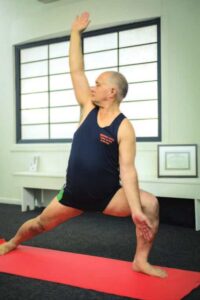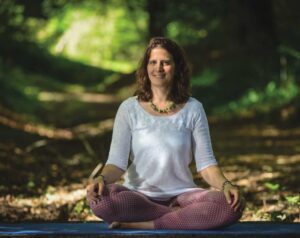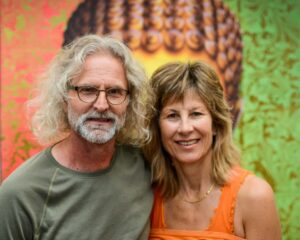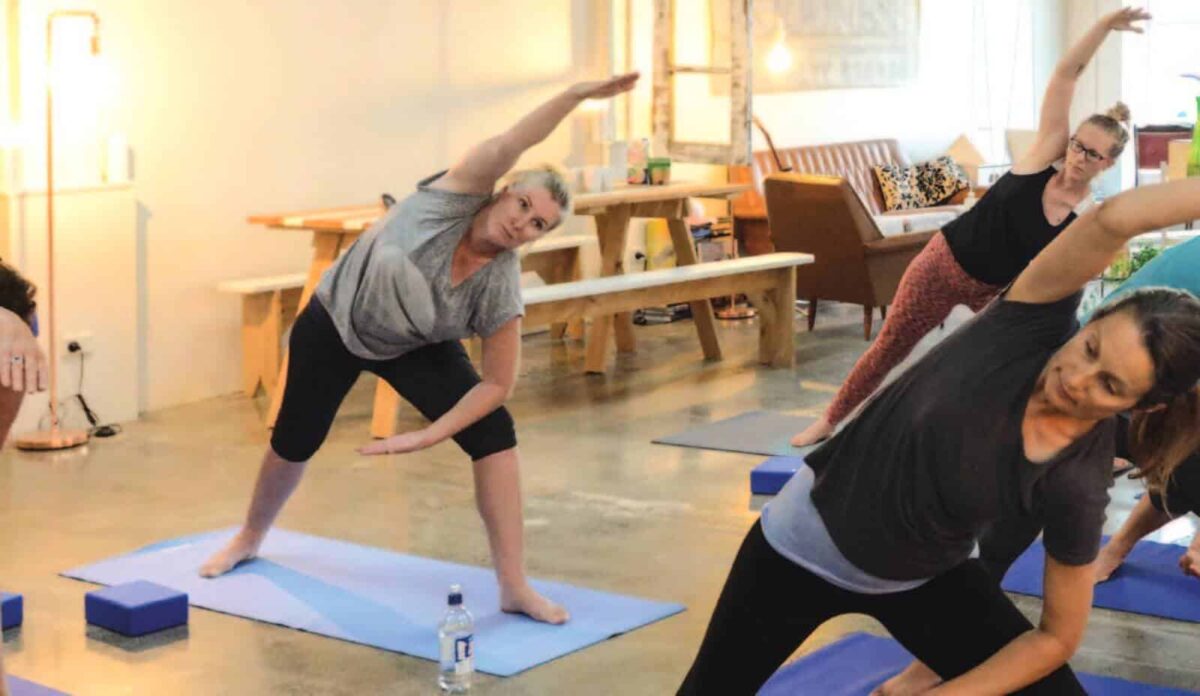IN the latter years of the 1960s, Time magazine ran an article on yoga which featured a teacher in Sydney named Michael Volin.
At the time my father was experiencing severe lower back pain. His doctor in Napier recommended surgery.
Time magazine claimed yoga could alleviate, and in some cases heal, injuries of the spine, so dad packed his bag and spent a week with Michael Volin in Sydney.
He returned a yoga devotee, and every morning he would exercise in the sitting room, fi nishing up in a headstand. And he shared with anyone who was interested, and many who were not, the benefi ts of controlled breathing, postures, and cleaning the tongue with a spoon fi rst thing. We had a notice pinned on the kitchen wall – people who stand on their heads are bloody minded – a reminder to dad that his enthusiasm for yoga bordered on the obsessional.
His back was fixed.
Later he studied with Richard Hittleman in California and our whanau turned vegetarian at his behest. As a teenager, I often followed my father doing his asanas (postures), and pranayama (breathing): the 1-4-2 breath, alternate nostril breathing, the cleansing breath, and a hissing through teeth that left me pleasantly dizzy.
After leaving home I never did yoga again, so it was with nostalgic trepidation that I sat on a mat for the fi rst 2017 Beginners Class, Yin Yoga Napier, instructed by Carol Neilson.
“And he shared with anyone who was interested, and many who were not, the benefits of controlled breathing, postures, and cleaning the tongue with a spoon first thing.”
YIN
The practice room is pleasantly proportioned with a high ceiling and is situated on the fi rst fl oor of an art deco building in Napier.
After an introduction, Carol guides the group through a series of postures explaining the technique and their purpose. We are asked to hold the postures at whatever degree of difficulty we reach and breath into the places of resistance in our bodies.
Later Carol explains. “Yin is about slowing right down and fi nding the shape and form of the posture that fi ts your body. Yin asks that you be present in your body with whatever sensations are going on, physical and emotional.”
The word, Yin, comes from Chinese philosophy, and is the passive female principle of the universe. The yoga style was developed by American martial arts master, Paulie Zink, in the late 1970s as a way to bring flexibility to the strong (yang) but tight muscles of the martial artist. Zink’s technique was to hold traditional seated and supine asanas for three to five minutes, stretching connective tissue (fascia) around the joints.
“Yin works with meridian lines in the body, and when the postures press on the organs, the meridians are activated releasing a flow of energy. Some people finish a session a bit out of it. I call it yoga stoned, because of the release of energy.”
And Carol points out, “Yin works with meridian lines in the body, and when the postures press on the organs, the meridians are activated releasing a fl ow of energy. Some people fi nish a session a bit out of it. I call it yoga stoned, because of the release of energy.”
In the forward bend my lower back and shoulders ache. Carol instructs to breath deeply and rhythmically into the points of discomfort, and imagine the breath dissolving the pain. I do as I’m told and it works, but alas, no yoga stone.
Carol Neilson was born in England, emigrating to New Zealand aged seven. She fi rst trained and practised nursing. Later she had a career in education and personal development.
“My work has always been with people, communication, and healing.” Yoga seemed a natural fi t with her fascination of “neuroscience and mind-body connection, which we’ve known about for centuries, but now have the science to support.”

Carol is referring to mBraining, and its therapeutic capacity mBIT (Multiple Brain Integration Techniques), based on the concept that intelligence lies not only in our brains, but in our hearts and stomachs also. And she references ancient knowledge of chakras when she says, “Our emotions are held in our bodies; grief in the lungs, anger in the liver, fear in the kidneys.”
Integrating the latest neuroscience discoveries and ancient knowledge into yoga practice is exciting territory for Carol Neilson. “We can change our wiring. We can change our DNA, and the lineage we’ve arisen from.”
BIKRAM
In contrast to the slow-paced gentility of Yin, Bikram yoga is a serious workout, consisting of twenty-six connected postures, performed in a room heated to around 40C degrees.
In his studio above the old State Theatre in Hastings, Jack Smith, runs a busy schedule beginning at 6am. Hastings born, he was an HR manager at Wattie’s Industries, and later with Goodman Fielder Wattie, based in Auckland.
When, at the encouragement of his wife and daughters, he “tried yoga”, at fi rst he “made a joke of it as most men do,” but soon the benefi ts to his wellbeing were obvious, and he decided he wanted to teach.
In 2008 Jack undertook a nine-week intensive Bikram teacher-training course in Mexico. Founder of the style, Bikram Choudhury, supervised the class of over three hundred students. Jack’s fi rst qualifi ed Bikram teaching was under the patronage of Dave Edwards in Auckland, and when he returned to Hastings, he taught at Pettigrew Green Arena, before opening his own studio in 2012.
Bikram Choudhury’s system of yoga, developed in the 1970s, begins with pranayama breathing followed by eleven standing asanas. They are traditional yoga poses, as are the fourteen asanas performed on the fl oor.
In the class, Jack Smith guides his students through the poses in a rapid delivery of instructions, reminiscent of an auctioneer. “Breath, breath, pull, stretch, breath, breath, eyes open, lock your knees, lock your knees, last chance, lock your knees.”

It’s part of the full-on Bikram system and Choudhury has a reputation for treating his students harshly. He pushes his students “for a purpose, to take them further than they thought possible,” says Jack.
“I see how flexible my own grandchildren are,I tell my students, when you were a kid you could do these poses, which means you’ve still got it in you to return that state of flexibility.”” JACK SMITH, BIKRAM YOGA
Now sixty-two years old, married to Rama for forty-four years, and a devoted family man, it’s not in Jack Smith’s nature to bully. Rather he borrows from his life experience in encouraging his students. “I see how fl exible my own grandchildren are,” he says. “I tell my students, when you were a kid you could do these poses, which means you’ve still got it in you to return that state of flexibility.”
Jack calls it the Benjamin Button syndrome after the character who grew younger as he aged.
His experience also informs him that resistance to going further in postures is often “a blockage in our brain telling us we can’t do it, but much of that is fear-based, because the last thing we need is to injure ourselves and put our work at risk.”
Bringing a gentle touch and wisdom to his Bikram teaching style, Jack Smith o ers a vigorous yoga workout designed to improve fl exibility, general fitness, and wellbeing.
IYENGA
In her house on the beachfront at Te Awanga, Lucinda Sherratt has a studio where she teaches private clients in Iyenga yoga. She also conducts regular group sessions at different locations.
A feature of Iyenga is the use of props. “To help those who are less fl exible get into a pose, or for people who are more fl exible to get deeper into a pose,” says Lucinda. And she shows me by winding a strap around my arms to assist her pulling me into a backward bend, over a bolster, while kneeling on the ground, a position I could not achieve without help. What surprised me was how happily my body accepted assistance.
What distinguishes Iyenga teachers from others “are the very strict guidelines of teaching di erent levels of poses,” Lucinda explains. “To become a top Iyenga teacher takes thirty years, and a teacher cannot take students, or themselves, beyond those poses, the idea being you are guided through poses that suit your stage of development.”
Lucinda Sherratt attended her fi rst yoga class in Auckland in 1999, but she was working in the fi lm industry at the time, and it wasn’t until she traveled to India en-route to France did she do “lots of yoga”.
As if fate was guiding her, opposite her apartment in Paris was a yoga school. “The teacher was a blind woman who only spoke French, so it was hard core listening to understand what she was saying.”
Returning to India, Lucinda spent fi ve weeks at Sivananda Ashram in Uttarkashi, and “really got hooked”. Deciding to deepen her practice and knowledge, Lucinda attended Wellpark College of Natural Therapies in Auckland, where, among other disciplines, including Ayuvedic medicine, she studied the philosophy of the eight limbs of yoga.
“A lot of people think yoga is the asanas, doing the exercises, but they are just one aspect of an eight-fold process ending in enlightenment, and it’s up to the teacher to introduce pranayama breath control.”

The fi rst limb are the Yamas, rules of moral code that include non-violence, truthfulness, not stealing, and sexual restraint. The Niyamas are rules of personal behaviour – purity, contentment, discipline, spiritual study, and devotion. Asanas (postures) and Pranayama (breathing) rank third and fourth of the limbs on the path to merging with the divine, Samadhi.
The classical purpose of physical yoga is to prepare the mind and body to attain perfection of the limbs preceding enlightenment.
Pratyahara is withdrawal of the senses. Dharana is concentration. And Dhyana, the practice of meditation.
Passionate about the philosophy and the practice of yoga, Lucinda Sherrat returned to India in 2012 to further her study of Iyenga yoga. She was already teaching, fi rst in Auckland then Hawke’s Bay, and had “practised many di erent yoga styles, but the only one that speaks about alignment in such detail is Iyenga.”
“A lot of people think yoga is the asanas, doing the exercises, but they are just one aspect of an eight-fold process ending in enlightenment, and it’s up to the teacher to introduce pranayama breath control.” LUCINDA SHERRATT, IYENGA YOGA
B.K.S Iyenga was ninety-two years old when Lucinda attended his ashram in Pune. He was no longer actively teaching. His granddaughter, Abhijata, had assumed that role, but the old man still attended, practising for three hours a day.
Explaining the focus on alignment, Lucinda says, “Mr Iyenga talks about the skin of your palm; how is the skin of your palm sitting in downward dog? The deeper you go into how the spine, joints, muscle structure, and organs are aligned, the deeper you become aware of di erent levels beyond raw physical matter.”
There are fi ve levels of Iyenga certifi cation. Lucinda Sherratt is Junior Intermediate Level 1, the highest graded teacher in Hawke’s Bay.
Being a keen promoter of yoga, Lucinda has helped organise a two-day introduction programme at the Bostock Edible Garden Show, being staged at the Showgrounds in Hastings. Five teachers will take half-hour classes from 10am to 12.30pm, 25 and 26 March.
PREGNANCY
The day we meet is the tenth anniversary of Rachel Chapman’s arrival in New Zealand. She came as a volunteer for DOC, joining a conservation project on Tiritiri Island in the Hauraki Gulf.
Born in Yorkshire, Rachel fi rst practised yoga at university, and after graduating to a stressful marketing management job, “found yoga as a way to relax and unwind”.
In her holistic approach, Rachel Chapman’s aim is to “reduce the stress during pregnancy, and in the early years, so we create an easier space for the child to grow into themselves.” RACHEL CHAPMAN, PREGNANCY YOGA

Today she is a graduate of the International Yoga Training Association, and specialises in yoga for pregnancy, pre and post natal, which she trained for in London. Rachel started teaching yoga to pregnant women when she was herself pregnant with her fi rst child. She met her partner on her working holiday.
Soon after the birth of their daughter, the family moved back to Rachel’s home in North Yorkshire, a rural community, where she taught yoga with the support of Sure Start, a government programme assisting parents and children from pregnancy until four years old.
On returning to live in Havelock North fi ve years ago, Rachel saw that, “nobody was o ering consistent weekly classes,” so, she did.
Her teaching of pre-natal women is “physical, emotional, and spiritual preparation for birth”. Asanas include, “physical support of the pelvis which opens for birth,” and, “breathing helps with the fear and anxiety. The breath is the constant,” says Rachel. “No one else can do that for them.”
Encouraging “women to make a connection with the baby,” is a focus, and as Rachel points out, “babies can hear their mother’s voice from eighteen weeks”. From her own experience she recalls, “I did a lot of chanting while pregnant with my fi rst child, and after the birth, one day I chanted, and my daughter obviously recognised.” In post- natal classes Rachel teachers mother’s “to use chant or the breath to calm their babies”.
In her holistic approach, Rachel Chapman’s aim is to “reduce the stress during pregnancy, and in the early years, so we create an easier space for the child to grow into themselves.”
Rachel also teaches adult classes in a meditative yoga termed ‘hidra’, which brings deep relaxation to the body, and calming of the mind.

HATHA
“All yoga is hatha,” says Doris Blum when I meet with her and her husband, Urs, in their studio in Havelock North. I asked because the class I’m attending with Doris is described so, and I assumed hatha was a separate style of yoga, but I discover this resourceful couple have a holistic approach to teaching where, “a student shouldn’t have to fi t the practice, the practice should be designed to fi t them.”
Urs explains. “All modern yoga comes from the same source, that is, Krishnamacharya (1888-1989). He taught B K S Iyenga, Pattabhi Jois (Ashtanga), and many others, including Mohan.” A feature of Krishnamacharya’s approach was that every student is absolutely unique and should be “taught according to his or her individual capacity at any given time.”
Krishnamacharya’s respect for the individual was informed by his practice as a doctor in Ayurvedic medicine, which recognises the unique composition of each person, yet fi tting one of three general physical/mental/emotion types; the doshas – Vata, Pitta, and Kapha.
Doris and Urs have blended their knowledge of Ayurvedic medicine with their yoga.
“I fi nd it very helpful to look at individual personalities from an Ayurvedic perspective,” says Doris. “It allows us to look at issues from a wider perspective – from a therapeutic yoga perspective,” Urs adds.
It was Doris who initiated the journey into yoga. After a dinner party with friends one of the guests demonstrated some poses. She was Napier yoga teacher, Claire Woodham, and Doris was impressed, so she attended her classes.
The Blums settled in Napier in 1995 after “falling in love” with New Zealand on a holiday fi ve years earlier. “Switzerland is very much career oriented and you just go, go, go and don’t deviate from that path,” says Doris. “We wanted a life where we could spend more time together and not just work, work, work.”
However work did not escape them. On emigrating, the couple established and operated The Masters Lodge, an upmarket BnB on Blu Hill. “It was 24/7,” says Doris, and only after selling the Lodge in 2001 did she have time to follow her passion for yoga.
“We encourage our students to try out the different styles until they find one that suits them,” says Urs. “We’re all looking outside for things to make us happy,” Doris says, “but it’s being in the moment, being in the breath, then you will discover something different.” URS AND DORIS BLUM, HATHA YOGA
Doris studied in Cairns with renowned yoga teacher, Nicky Kno , and later found a man she considers her “prime teacher”, John Scott. “I fell in love with his personality and the way he teaches from the heart.”
Urs was attracted to yoga, ‘After seeing the positive changes it was having on Doris.” “I wasn’t so nasty,” says Doris with a chuckle.
Their interest in Ayurvedic medicine saw Doris study at Wellpark College, and Urs follows the teachings of A G Mohan, founder of Svastha Yoga and Ayurveda. The Sanskrit meaning of Svastha is ‘to stay in one’s own abode’ – the Eastern sensibility to the Western adage, ‘Know thyself’.
“We encourage our students to try out the different styles until they fi nd one that suits them,” says Urs. “We’re all looking outside for things to make us happy,” Doris says, “but it’s being in the moment, being in the breath, then you will discover something di erent.”
The class is full, and starts with a sitting meditation, focusing on the breath. Soon we move to asanas both standing and sitting. Some students are familiar, gliding fl uidly with the routine. A few are not as adept, though none as infl exible as me. Doris helps with instructions, but I’m too much a novice to keep up.
Doris and Urs Blum have a loyal following in their evolving holistic approach to yoga, and they generously share their Breath studio with other teachers.
For twenty-one years, starting in 1985, Peter followed a course of study under the late Sri K Pattabhi Jois (1915-2009) the father of Ashtanga Vinyasa yoga. Ashtanga means eight limbs (of yoga), and Vinyassa, is movement. PETER SANSON, ASHTANGA YOGA
ASHTANGA
When I asked Doris and Urs what their style of yoga was, they said “Ashtanga”, and were quick to point out that Hawke’s Bay is privileged to have one of traditional Ashtanga yoga’s most respected exponents residing and teaching here.
Peter Sanson was in Mysore, and I didn’t speak to him, but his reputation is well documented. Google his name and there are over five pages.
For twenty-one years, starting in 1985, Peter followed a course of study under the late Sri K Pattabhi Jois (1915-2009) the father of Ashtanga Vinyasa yoga. Ashtanga means eight limbs (of yoga), and Vinyassa, is movement.
In the fl yer to a workshop he is teaching in Barcelona in June, Peter Sanson is introduced as “a very good opportunity to practise with one of the oldest students of Pattabhi Jois who has maintained the purity of practise with devotion and humility.” The Copenhagen workshop of his 2017 European teaching tour says, “Peter is from New Zealand and a rare and genuine teacher with long term relations to Mysore and Guruji’s teachings.”
Having missed the opportunity to speak with Peter, and witness his teaching, instead I attended a one-on-one demonstration at the Shri K Pattabhi Jois Ashtanga Yoga Institute in Mysore, courtesy of YouTube.
What I viewed was a series of repeated asanas, often linked with jumps, then held for a count. The session ended with pranayama and meditation. The practitioner was skilled and graceful and the overall image was a dance of meditation in movement.
From Doris’s class, and earlier observing the beginning of Urs guiding two students, their infl uence from Ashtanga is obvious.
What distinguishes Mysore style is strict adherence to patterns and forms which do not allow for deviation, and like Iyenga, takes decades to pass through the layers of complexity.

Peter Sanson holds Advanced B teaching certifi cation from the Mysore Institute, a rare accomplishment for a Westerner. His studio is above Chantelle in Napier. Classes are held daily, except Friday and Sunday, and the next workshop is four days over Easter long weekend.
Returning to yoga after fifty years has been a journey in memory and discovery. The postures I learned as a teenager are mostly unchanged, and that the breath is a core of practice, is the same. What I didn’t appreciate then was that yoga as a portal to physical, mental, and emotional wellbeing.
In Hawke’s Bay we are fortunate to have teachers of many yoga styles o ering regular classes. Whether it’s physical fi tness you’re after, or something deeper, there’s a style to suit every aspiration.

